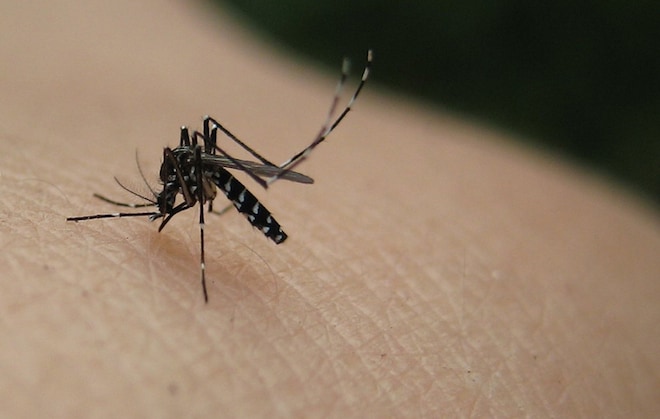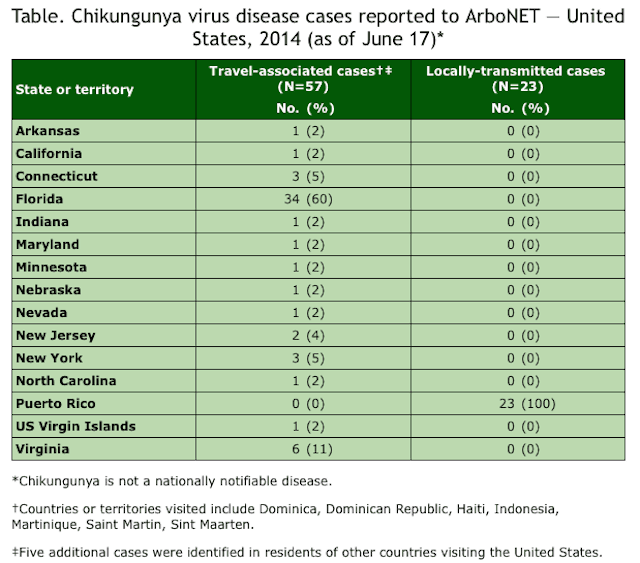
NatureGirl78 (CC), Flickr
If you happened to be reading state health departments’ outbreak announcements this past weekend, you might have seen something interesting.
(You don’t do this? Hmm.)
Three states — Rhode Island, North Carolina and Tennessee — all said that they have identified residents who have been diagnosed with the mosquito-borne tropical disease chikungunya. The states said all the victims had recently returned from the Caribbean, where the severe, painful illness has been spreading since late last year.
People in three states, all having visited the same place, all with the same illness: As a faithful armchair-epidemiologist, I couldn’t help but wonder whether they were linked in some manner, perhaps by a cruise or a church trip. As it turns out, the victims announced last weekend represent something more subtle and potentially more troubling: an increasing number of US residents acquiring the disease abroad and returning to the US with it — and posing the question of whether it will spread to mosquitos, and then to other humans, within this country’s borders.
What do I mean by “increasing”? This, for instance. The Centers for Disease Control and Prevention report chikungunya among US residents weekly on their website. Last week, the count for this year was 39. On Tuesday, it doubled, to 80.
And those numbers may well be an underestimate, because chikungunya is not what public health authorities call a “notifiable” disease — meaning, when a case is diagnosed, no one at the CDC or in a health department needs to be told about it. So there may be cases that authorities don’t know about, not to mention ones that physicians have misdiagnosed or not recognized.

The CDC’s most recent count of the distribution of chikungunya in US states (original here).
Chikungunya has been spreading in the Caribbean with incredible speed, as this piece published June 6 in the CDC’s weekly bulletin makes clear:
In December 2013, the World Health Organization reported the first local transmission of chikungunya virus in the Western Hemisphere, with autochthonous cases identified in Saint Martin. Since then, local transmission has been identified in 17 countries or territories in the Caribbean or South America (Anguilla, Antigua and Barbuda, British Virgin Islands, Dominica, Dominican Republic, French Guiana, Guadeloupe, Guyana, Haiti, Martinique, Puerto Rico, Saint Barthelemy, Saint Kitts and Nevis, Saint Lucia, Saint Martin, Saint Vincent and the Grenadines, and Sint Maarten). As of May 30, 2014, a total of 103,018 suspected and 4,406 laboratory-confirmed chikungunya cases had been reported from these areas. The number of reported cases nearly doubled during the previous 2 weeks.
More than 95% of the cases have been reported from five jurisdictions: Dominican Republic (38,656 cases), Martinique (30,715), Guadeloupe (24,428), Haiti (6,318), and Saint Martin (4,113). The highest incidences have been reported from Saint Martin (115 cases per 1,000 population), Martinique (76 per 1,000), Saint Barthelemy (74 per 1,000), and Guadeloupe (52 per 1,000). Further expansion of these outbreaks and spread to other countries in the region is likely.
On Tuesday, just two weeks after that piece was published, the case count in the Caribbean was 165,990 suspected and 4,576 laboratory-confirmed.
I spoke to J.Erin Staples, MD PhD, a medical epidemiologist in the CDC’s arboviral diseases branch and one of the authors of that June 6 piece, about whether there is an explanation for the apparently rising number of US residents with chikungunya. The disease “was mostly in the French Caribbean territories to begin with,” she said. “But we have begun seeing more cases since it has moved into the Latin American countries. That is probably because those are places where a lot of American travelers go, either to go on vacation, to work or to visit family.”
To this point, all the US residents diagnosed with chikungunya were infected outside the country; there is no evidence that anyone has acquired the disease within the US. Health authorities wonder, though, whether that can happen. Once the virus multiples in someone’s blood enough to cause symptoms, it can be picked up by a mosquito that bites that person, and then transmitted when the bug bites someone else in turn. That pattern has caused the mosquito-borne disease dengue to become re-established in Florida. The same mosquito species that spread dengue spread chikungunya as well.
As Tennessee state health commissioner Dr. John Dreyzehner acknowledged over the weekend, regarding the possibility that chikungunya might find a home in the US: “It is, unfortunately, probably just a matter of time.”